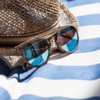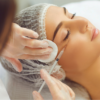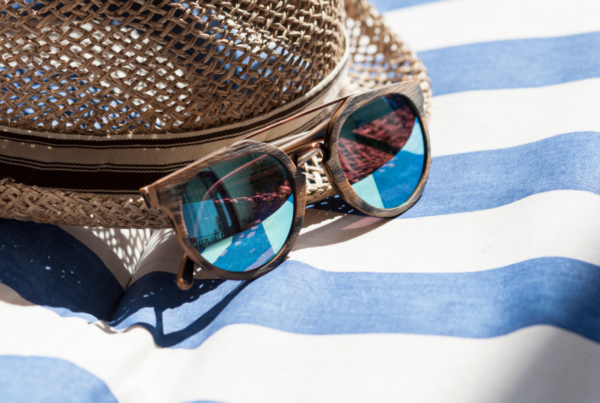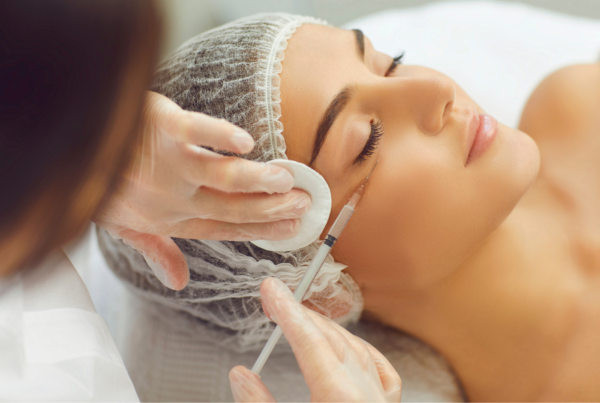The Dispensing Journey
Being a Dispensing Optician, I sometimes forget that the customer journey must feel daunting for the relatively new optical clientele. It’s a clinical environment but with a whole shop floor, full of consumer goods, which to the untrained eye, must look very similar. Hopefully, I can shed some light on what a customer journey can be like for someone entering the Opticians.
Image Credit: David Clulow
We have already looked at the eye-exam journey in ‘Part 1: The Eye Test’. In short, the customer has usually pre-booked their Sight Test and attends the appointment just like you would at a GP or Dental visit. Once the customer has ‘booked in’ at the reception desk, they will wait for the Optometrist to call them into their appointment, or start browsing at the frames whilst waiting. The latter part is great because you wouldn’t ordinarily have a broad range of products to browse, at any other Health appointment. The Dental surgeries may have toothbrushes to look at in a cabinet, the GP surgery will have lots of leaflets and magazines available to view, and even beauticians have shelves of products at the front desk, but nobody else in the Healthcare industry provides a whole array of retail therapy.
The Opticians are a haven of Ophthalmic Eyewear for the consumer to try on at leisure. It is the only Healthcare profession that has a large showroom of optical products for customers to try on before a possible purchase. Over the decades, the very rigid, clinical optical practices of the yesteryears are regenerating themselves into optical ‘boutiques’. The sight test provides clinical care, whilst the dispensing and optical correction has become more aesthetically driven than ever before.
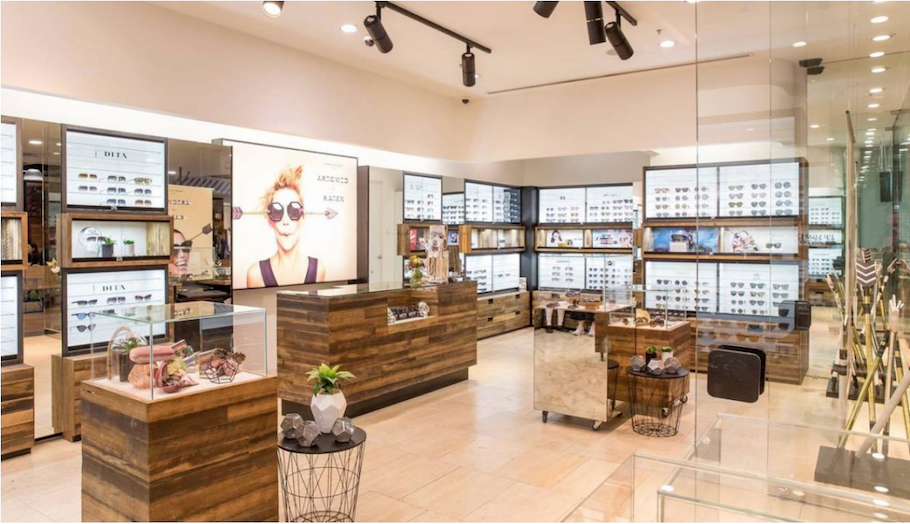
Moot eyewear store in Melbourne, Australia. Image Credit: www.weloveglasses.com
Customers can freely walk into an Optician’s, with or without an appointment, look at the optical goods, try them on and walk away without the obligation to purchase any services, goods or products. This is retail. It is no different from walking into a shoe shop to see if you like the products, the style and the fitting. If you like what you see, you order the product. The optical trade is different from the other Health professionals based on this type of customer journey. Most of the service industries will be appointment driven (Dental, Doctors, Podiatrist, Audiology, Hairdressers, Beauticians and the list can go on). The customer only visits these services when the need arises. The optical sector is completely different. Consumers are welcome to enter the Opticians as they please.
Important update: Due to the Covid pandemic, Opticians nationwide have taken measures to control practice management. This may include a locked-door policy, all visits by appointment only and a ‘do-not touch’ display protocol to minimise the spread of the virus.
So let us take a look at the average patient journey after the customer has completed their sight test. If a patient has a combination of healthy eyes and no prescription is required (meaning they do not need spectacles or contact lenses), they will make a payment for the service and leave. NHS customers will sign a form as a declaration of their NHS entitlement for the sight test and subsequently the NHS pay for the clinical care of the Ophthalmic Optician (also known as the Optometrist) directly to the practice. The appointment is not ‘free’ as so many customers like to put it. When anyone pays Tax, they are contributing to the country’s commendable NHS system. From this NHS funding, the entitled customers receive their NHS sight test.
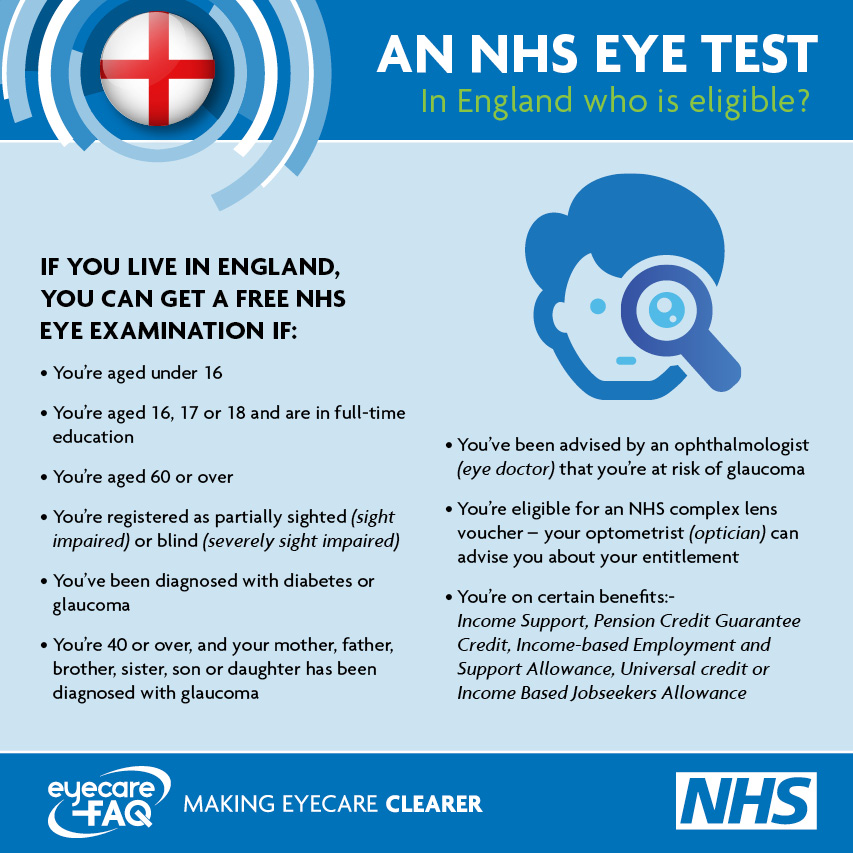
Image credit: abdo.org.uk
Eye Correction Has Been Recommended
If a patient has healthy eyes but they need optical correction, the Optometrist will introduce the customer to the Dispensing Optician or sales staff, who will further guide the patient on various frame and lens options. Lots of customers are pushed for time, so they will often ask how long the selection process will take. The answer is, it is up to the patient. Ultimately, the frame and lens decision will rest upon the consumer’s final choice. So, if you’re a customer, think before asking this question because it is like asking ‘how long is a piece of string’.
In the ideal scenario, all patients should be seen by a qualified Dispensing Optician for the spectacle dispensing. But, unfortunately, most customers do not know who they are being dispensed by. The Dispensing Optician is the professional advisor for the best corrective eyewear, lenses and low vision aids for various optical solutions and scenario’s (sport’s protection and safety eyewear to name a few). Dispensing to children and the visually impaired must be supervised by the Dispensing Optician or Ophthalmic Optician, who are registered with the General Optical Council (GOC).
Whenever I meet and greet a customer, I always give them my name and I let them know that I am the Dispensing Optician. By doing this, I am letting the patient know that I am the most qualified to best advise the customer on their optical solution. For the general public, it is very important to highlight that not all optical retail companies employ Dispensing Opticians. The majority of the staff will be optical sales assistants and their work is supervised by a professional. In some cases, this may only be the Optometrist, who is usually testing in a room. If as a customer, you feel that you need professional help for an optical order, please ask to liaise with the Dispensing Optician. If an Optical Organisation does not employ a Dispensing Optician, you have to wonder who will be available to resolve your technical query.
Ordering Spectacles; otherwise known as ‘The Dispense’
Coming back to the customer journey, when a patient sits down with the dispenser to discuss their visual correction, it is a good time to get a general price on the best-recommended solution. These could be single vision lenses (lenses solely for long-distance, near-vision or VDU-specific specs as a few examples), bifocals, varifocals, occupational lenses, sunglasses and any other correction with various add-ons (anti-glare options, UV protection and many more). If a customer knows what to expect from the price of their lenses, all they need to do then is add on the price of the frame selected. Some opticians will have prices that include the frame and lenses (all additional add-ons are extra), and some opticians will keep the frame and lenses at a separate price. The latter opticians usually have a much wider range of lenses and a much broader range of lens extra’s which is why they keep the frame and lens prices separate. The chain opticians will often use lenses from one sole provider but the independent or franchise opticians will have access to a multitude of lens catalogues.
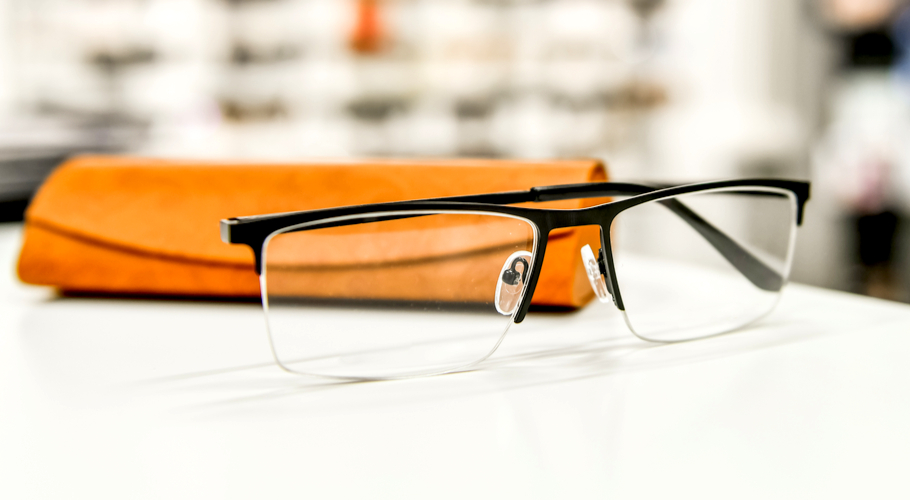
Image credit: Shutterstock
I have worked for all the various types of optical retail companies over the past 25 years, from the obvious chains to family-run and independent businesses. The chain branches have the advantage of bulk buying stock and negotiating cheaper lens deals with the lens suppliers. Therefore, they pass this cost-saving to the consumer and the customer has the advantage of buying something a little bit cheaper and often with deals thrown into the package. On the other hand, independent practices focus all their attention on quality, rather than quantity. For the discerning customer, the designer frames are generally the same price from one independent business to the other but the real difference comes in when a customer wants a specific brand of lenses (important for customers who are wearing multifocal lenses). This is where the independent opticians excel. They will often have all the lens accounts (Essilor, Zeiss, Hoya, Nikon, Rodenstock, Shamir, Tokai and many more). Each lens company is brilliant and unique in its own way. But if a customer has become accustomed to a specific varifocal design, and they are unable to adapt to any other brand, the independent optician is the most likely source to get the desired result for the customer. The other advantage that independents have is that they can order most frames in all their different sizes and colours whereas chain opticians only bulk order the most popular ranges.
In terms of advice given to a patient, this comes down to the expertise of the dispenser that you see. It is always the people that make a company. If the staff are well trained and conduct themselves with a professional attitude and a genuine willingness to help the customer, it doesn’t matter whether the optical practice is a chain or an independent, consumers remember the service and relate this to the place that they visited.
Every dispenser will have a distinctive way of dispensing to customers. If an adult is being prescribed spectacles for the 1st time, the prescription will likely be of a low value. In this scenario, I re-assure the customer that the lenses will be very light and without any obvious edge thicknesses. This often makes the patient feel much more at ease. I guide the customer on the best fitting frame and pick out some good examples for them. After this point, I would give the customer some time on their own to browse other frames, using the good fitting frame as a guideline of the optimum fit. Once the customer has made their frame choice, I will sit them down to discuss lens options and take any relevant measurements.

Image credit: Shutterstock
If a child requires a first-time spectacle correction, I will discuss the prescription details with the parent. This is especially important if the prescription has been brought in from another Optician’s or from the local eye hospital. The reason for this is because the lenses may be a little bit thicker than what the parent is expecting. Hence, the frame styling becomes more relevant, since some frame shapes, and types, exasperate the lens thickness. It is best to maintain customer expectations from the early onset of any frame order.

Image credit: Shutterstock
As mentioned earlier, existing spectacle wearers may wish to confirm the lens price at the beginning of the dispensing discussion. For example, this tends to be the case where customers are changing from single vision correction into multifocal lenses. The customer is given the lens options and prices first and then guided to the frame selection. The patient would be advised on the most appropriate frame choice for their spectacle requirement. Again, as soon as the frame and lens combination has been finalised, the dispenser would take all the required measurements to complete the order.
It is important to let customers know that some frames require additional extras on top of the basic lens price quoted. This is relevant to rimless, supra and in-line frames where stronger lenses are applied to toughen the exposed lens edges.
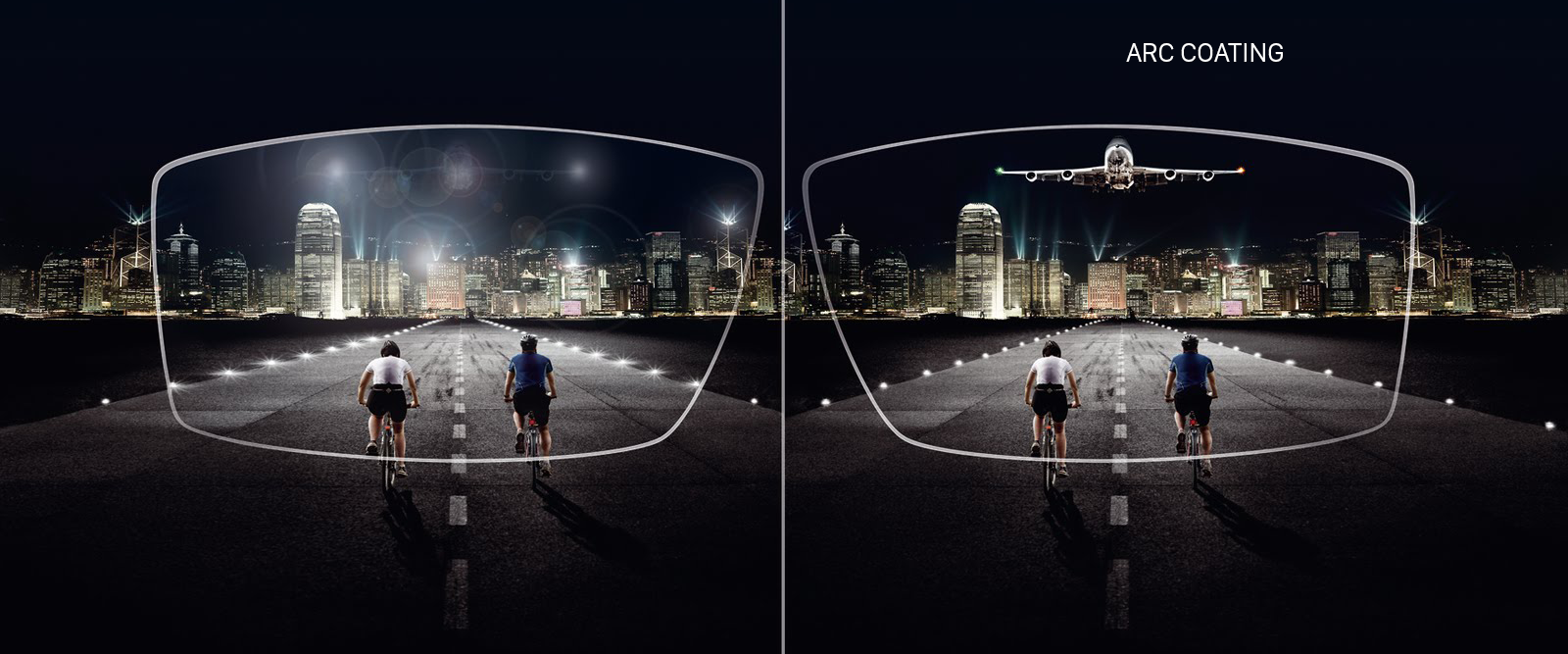
Image credit: quora.com -Anti-reflection coat on lenses
Prescription Discussion
More often than not, patients come out smiling from the optometrist’s room, nodding their head in agreement with whatever was recommended by the optometrist, but at the dispensing desk the customer says that they will not update their glasses ‘for now’. When discussing the prescription with the patient, I reiterate what the optometrist has found in the room. I keep the terminology simple so that the customer is better informed of the relevance of their new prescription. A fine example of this is the Visual Acuity (VA) that is to be expected with the new correction. Visual Acuity is the indicated number on the large test room chart that allows opticians to identify the sharpest clarity of vision when an optical correction is worn by the patient. In simple terms, I remind the customer how many lines they could see in the test room chart with their existing correction and how many lines extra they can expect to see with the new optical appliance. When a customer understands the significance of this prescription, they will often appreciate the need to update their glasses.
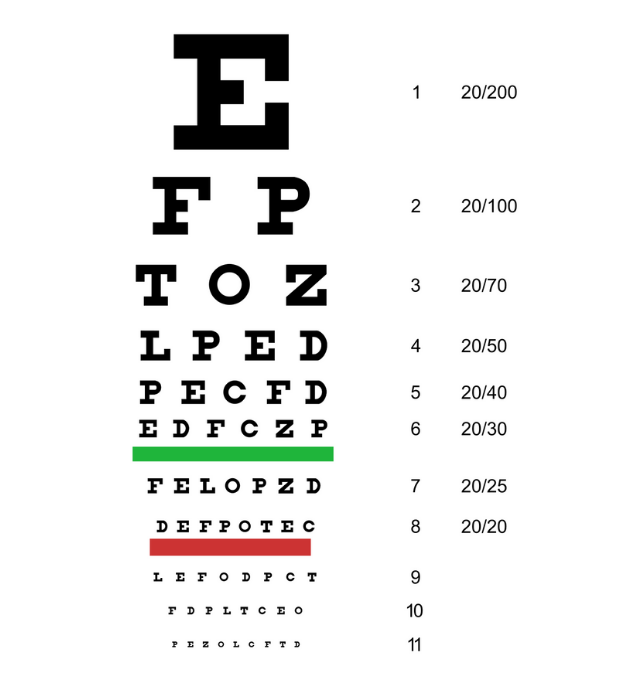
Image credit: Snellen Chart by Wikipedia
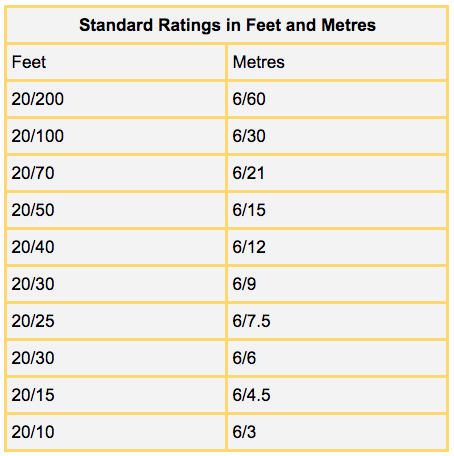
Image credit: Visual Acuity
Spare Glasses
If there is minimal change in the prescription and the vision is still good for the driving standards, the customer may not need to update the glasses until the next sight test. As a dispenser, I also check that the frame is still in good condition and that the customer has a spare pair of spectacles that also comply with the driving standard. A real bone of contention, for me, is that customers say that they have a spare pair of glasses, but actually the spare pair that they are referring to is damaged, warped or the prescription is 5 years +. The latter appliance does not qualify as a good spare pair if they cannot be worn or the vision is compromised. The onus is always on the patient to make sure that they are safe on the road for themselves and other road users. It is worth noting that in some European countries, the law stipulates that, as the driver, you must carry an up to date spare-pair of prescription eyewear. France and Spain are two common holiday destinations where this driving law applies.
As a customer, you should check if your spare spectacles are still suitable for driving, should anything happen to the main corrective pair. Do the spare spectacles need updating?
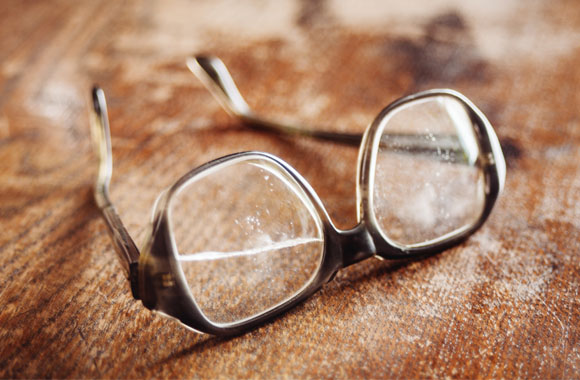
Image Credit: Essilor India – Warped and old glasses.
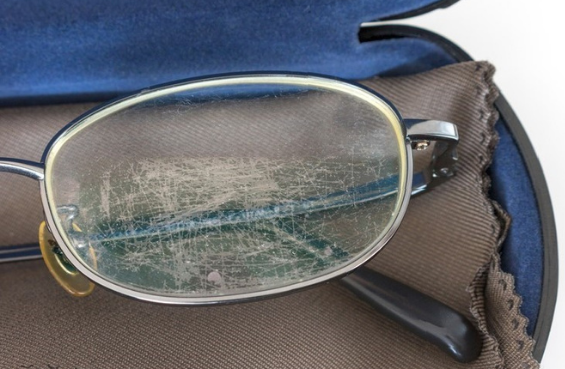
Image credit: Firmoo.com – Scratched spectacle lens
How good is your vision?
If a football were to suddenly be kicked into a road in front of you, how quickly would you be able to respond with your current glasses? Now consider this. What if the ball was smaller, like a tennis ball for example? The colour is paler and the object is smaller. Would you be able to see the tennis ball with the old spectacles? Push this thought a little further. What if the ball was the size of a golf ball? Would you be responsive enough with a smaller, light coloured ball? The most up to date spectacles could make all the difference. Spectacles that have the optimum prescription in them and the best surface quality (no scratches, chips or abrasions) will always produce the safest and most comfortable vision.

Not all pedistrians look, you as a passenger could prevent an accident. Image Credit: Shutterstock
Another regular comment I hear customers say is “I don’t drive, so I don’t need distance glasses”. But, ask yourself this. Do you not sit as a passenger in a car? Do you not need to see where you’re going, or do you just blindly go where the driver is taking you? If you’re standing at a bus stop or waiting for a train, wouldn’t it be so much nicer if you could see the number or destination on the public vehicle from further away? If patients wore the correct prescription, they wouldn’t have to squint when viewing objects in the distance. The same would apply to holidays and sightseeing. How can anyone appreciate details in what they are viewing with blurry vision?

Image credit: Pexels.com
It is always worth having the distance vision corrected when the Optometrist recommends it. During the eye exam, the Optometrist would show the patient the difference between the old prescription and the new. Where little difference is noted, the patient would not be prescribed spectacles. However, if the prescription allows you to see extra letters and lines on the testing room chart, this could make the world of difference for the most menial viewing tasks, such as watching TV. A person does not have to be a driver to appreciate the best distance vision.
One Pair of Spectacles Cannot Correct All Visual Needs
When prescribing spectacles, the Dispenser will ask several questions to best understand the patient’s visual demands. Unfortunately, there is not one pair of spectacles that can meet all the criteria required by some customers. A prime example of this would be the typical Varifocal wearer. Varifocals are designed to give patients a convenient mode of correction that caters for the distance, intermediate and near visual tasks, all in one lens. However, although the varifocal can do most of the day-to-day correction by blending these prescriptive zones, the customer may still need to supplement these main spectacles with other more specific-use glasses. The most obvious supplementary spectacles would be glasses for VDU use. The middle part of the varifocal lens gives the patient some intermediate viewing area but if the customer uses large VDU displays, with perhaps multiple display screens, a separate pair of VDU specific spectacles would be prescribed.
It would be worthwhile for the patient to check if their employer has any VDU funding scheme since a lot of companies provide concessions towards employee Sight tests and VDU-specific eyewear. Other supplementary spectacles that customers may consider are separate ‘reading’ glasses, sunglasses, sport-specific and protective eyewear. Whatever recommendations the optician makes, the consumer should be able to make a well-informed decision based on the options that they are offered.
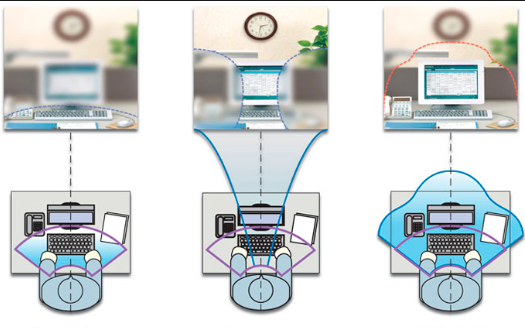
Comparison of single vision ‘near’, varifocals and occupational spectacles. Image Credit: Seiko Eyewear
Reglazing Spectacles
When customers have spectacles that are in good condition, it would be a reasonable choice to consider re-using an older frame. When we put new lenses into an old frame, we use the term ‘reglaze’. When considering a reglaze, the Optician will assess the frames re-usability, since we do not want to put new lenses into a damaged or brittle frame.
Metal frames are a lot more versatile than plastic counterparts. Provided that the metal frame is still in good shape and the joints are well aligned, the metal frame can be reglazed quite a few times. Using stainless steel or titanium frames would be even better since corrosion is less likely with these metals. If a nickel-metal frame is showing signs of corrosion, it is best to order a new frame and keep the old pair as spare. My advice for plastic frames is that they are great when first purchased and can be reglazed at least once. After one reglaze, I would advise buying a new frame. The reason for this is that plastic carries moisture in its material. When new or nearly-new, the plastic frame is more malleable. As it ages, the moisture is lost from the frame and it becomes more brittle. Since we have to apply heat to plastic frames to adjust them, an older plastic frame can easily crack at the heat application. This ageing process is not difficult to identify. Older clear or crystal coloured, plastic frames will exhibit cracks around the rims of the frame. The darker plastic frames will show white patches around the heated or bend-points. Customers who ask for a plastic frame to be re-adjusted at the end tips should be shown this ageing process before any adjustments are done since this type of frame is most likely to crack when aged.
At the end of the dispensing order, customers will generally pay for their order in full or leave a deposit. Another option that is offered to customers is a payment plan. Some Opticians offer interest-free payments over a period of time (Leightons Opticians).
I would always give the customer an approximate due date for their spectacle order. Some Opticians have a ‘same-day’ service. Other places may take a week to prepare an order. If a customer is ordering a niche product or safety eyewear, the orders can take more than 2 weeks. My advice to customers is, do not leave any special orders to the last minute. If you are going on holiday or you need new glasses for a special occasion, pre-order the spectacles in advance. It is unreasonable to demand spectacles for a specific due date. I personally never promise due dates, for there are too many variables that can cause delays in the spectacle order. As a professional member of staff, it is up to me to manage the patient expectations. If the customer is ordering their sunglasses a week before they are due to fly, they may not have their order for that particular journey. However, the spectacle order would be ready upon their return and would be used for future trips.
Collecting your Spectacle order
At the collection of spectacle orders, the final fitting of the optical appliance is done. This would entail adjusting the side-lengths of the spectacles to sit more comfortably around the ears. The main frame-assessment is done at the time of the dispense. Hence the frame should not be too tight or too loose across the head width, the arm length should be reasonable for a dispenser to lengthen or shorten as required and the fitting around the nose should be of the appropriate bridge size. When these considerations have been made from the on-set, the fitting stage is generally quite quick. Customers would check their vision in the long-distance if they are collecting distance-vision glasses, near vision for reading glasses or assess their all-round vision if collecting multifocal spectacles. With any change in prescription, adaption would be required. As we get older, the adaption process may take a little bit longer, but within a week, most customers have acclimatised to their new prescription.
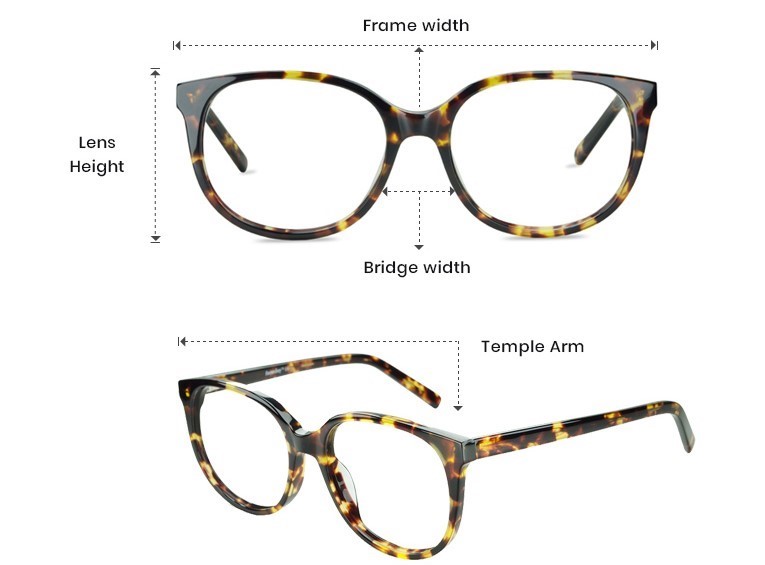
Image Credit: Framesbuy UK
Final Checks & Recommendations
At the collection phase, I always refer back to the Optometrist’s records and I check the level of acuity expected from the customer. If the customer, for example, has the onset of a degenerative eye condition that may lessen their acuity, and they are collecting reading glasses, I would ask the patient to start from the larger text and let me know how much they can read, as the letters become smaller. Once I am satisfied that the person is seeing the desired result, I let them know that what they are seeing meets our expectations from the sight test room. If a customer is tired or the prescription has changed significantly, I also recommend wearing the new spectacles from the following morning. This way, the eye muscles have rested overnight and are generally more receptive to the revised prescription.
More often than not, the biggest bugbear for all opticians is when customers cover 1 eye and test the opposite eye and vice versa. In short, even if both eyes have excellent VA’s and a similar prescription to one another, 1 eye will always be more dominant than the other and a difference may be noticed. However, we do not walk around cupping 1 eye at a time. From binocular viewing, the brain deciphers the clearest image. To put this in a simple context, the human body is designed to have two arms and two legs. So why is it that some people are right-handed whilst others are left-handed? By being more dominant on 1 side of your body doesn’t lessen the necessity of the other side. If you don’t question which hand you write with or which foot you kick a football with, why do customers become so pedantic when it comes to the dominance of the eye? In clinical cases, where 1 eye genuinely is seeing less than the other, due to an eye condition (such as a cataract for example), the difference in the VA is mentioned and shown to the customer in the eye exam room and so at the collection, this difference would be apparent.
Spectacle care
During the collection point, I always reiterate spectacle care. It is vital to use the appropriate microfiber cleaning cloths to clean the lenses. Customers can also buy solutions and wet wipes designed to clean the spectacles. The optical appliances are comparable to the most elite camera lenses. When consumers buy expensive watches or cameras, they always ensure that the lens surface is kept clean and the appropriate solutions or cloths are used to avoid surface damage. The same logic must be applied to your optical eyewear. For the spectacle lens to do its job, the onus is on the wearer to keep the surface clean and scratch-free. When a camera is not in use, we close the shutter to protect the camera lens. Likewise, keep your spectacles in the case provided to avoid any unnecessary damage. Spectacles are not unbreakable. They are not scratch proof. To prolong the life of your glasses, look after them and they will continue to look after your visual needs. By wearing spectacles on your head or throwing them into a coat pocket unprotected, you are severely compromising the quality of the glasses.
When customers cause accidental damage to their eyewear, they must pay for replacements. The manufacturing warranty covers exactly that; ‘a manufacturing fault’. It does not cover accidental damage. Consider this: If as a consumer, you damage the car tyres or alloys of your car, who would pay for the damage? You would of course, or at the most your car insurance. If you damage your phone, who pays for it? You or your insurance company pay for the charges. So, if you go into the opticians with accidentally damaged specs, you would have to pay for the replacement item. To reiterate, damaged glasses do not constitute a warranty issue.
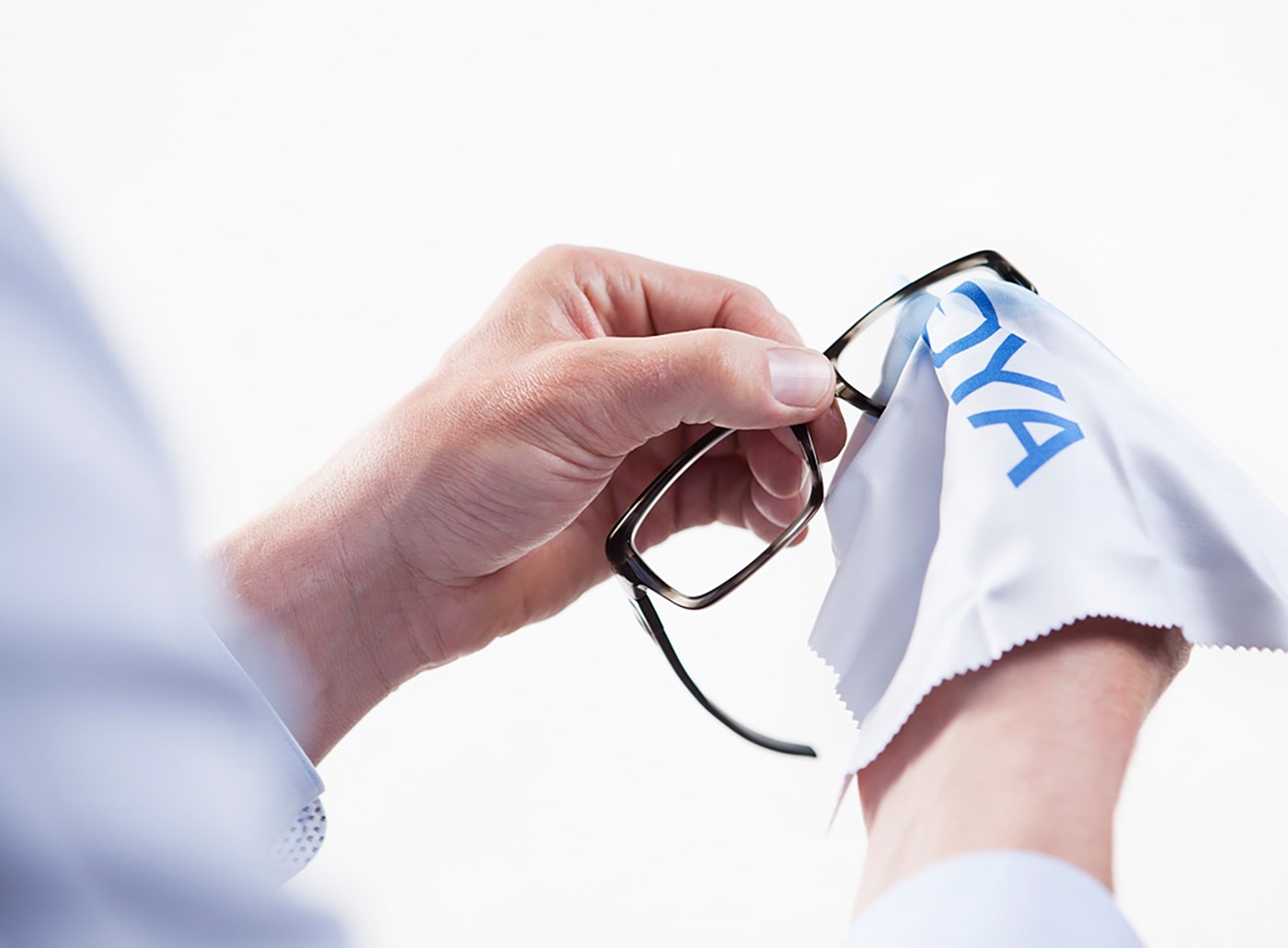
Image Credit: Hoya Vision–Microfiber cleaning cloth.
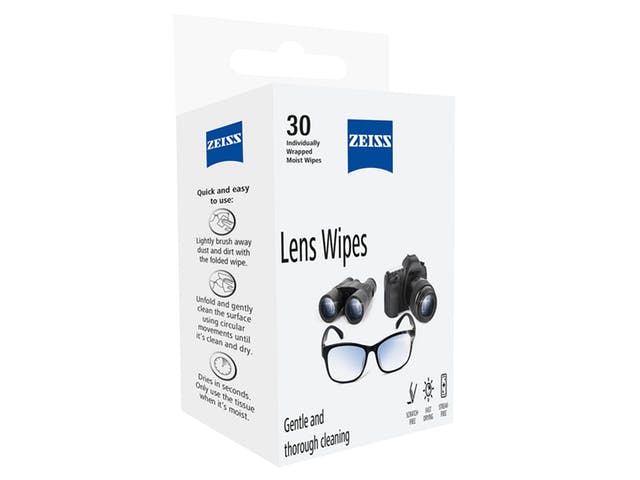
Image Credit: Zeiss– lens wipes
The spectacles do not just have a monetary cost associated with them. They are a valuable tool for your vision. If customers damage their glasses, it can impair the ability to function for all general tasks. If a patient loses or damages their only distance glasses, and they cannot drive, just imagine the consequences that this would have. How would you drive to work or pick up a child from school? In short, consumers must become more responsible. In this day and age, too many people want to pass the buck and play the blame game. Opticians are not to blame for careless handling of glasses.
The Aftercare
After customers collect their spectacles, the aftercare is always there. Patients can pop in at any time for minor ‘tweaks’ or adjustments. Mostly all consumer products, from a broad range of industries, require servicing. Spectacles are just the same.
Dispense on another day
Customers do not have to order their spectacles on the same day as the Sight test. Especially with the new-age sight tests of today, the customary half-hour Eye Exam has become an hour-long experience, before the spectacle selection has even started. With the eye exam, pre-screening and additional testing facilities such as retinal scanning devices, the sight test has become a lot more thorough and informative. However, all of this additional testing requires longer visiting times. Customers find the testing procedure so long that they often decide to come back on another day to select new spectacles.
A patient can also get a quote and think about the various options or come back another day with a friend or family member to help decide on the frame selection. There is no obligation to order on the same day as the eye exam or even from the same practice that tested your eyes. As an optical consumer, a patient can order spectacles from several places if they so wish. Hence it is recommended that the patient keep a copy of their most up to date sight test with them. If a patient hasn’t got their sight test details at hand, they can give their permission to the retail source to contact the Opticians that carried out the original sight test to retrieve the relevant information.
At my workplaces, I save customer quotations and take all the relevant measurements so if the customer decides to proceed with an order at a later date or time, they can phone the practice and give their go-ahead for the spectacle order.
On this point, my advice to customers is that, if you’re not sure, do not buy. Once frames and lenses are ordered, the job goes ‘live’ with the suppliers within half an hour of the spectacle order being placed. This means that the order cannot be stopped or amended and since these orders are bespoke to a patient’s vision, as a consumer you could potentially lose up to 50% of your order value.
Optical Sales & Promotions
An additional afterthought is that a customer does not have to order all of their spectacles on the same day. If a customer wants to order new distance glasses, new near-vision glasses and sunglasses, they could consider ordering the spectacles over a course of time and best maximise on any sales or offers that may be available during the different seasons of the year. In this manner, a savvy consumer can spread the cost of spectacle purchases as well as optimise on any sales that may occur during the year. The best optical sales tend to be the New Year’s sales and Easter sales. The latter period is usually when all the new sunglass offers tend to pop up.
With today’s Social Media and data collection, many of the Optical Practices are sending out vouchers to customers registered on their databases. Whilst this may be a little bit annoying when we don’t need such mailshot, it can be to the consumer’s advantage when a spectacle purchase is to be made. Take advantage of these offers. Some businesses send ‘Birthday vouchers’ to entice customers to make a return visit. If, as a patient, you want a particular pair of sunglasses that you wouldn’t ordinarily purchase, use the promotions that are on offer to you to bring the cost down. If your friends and family want to buy you a gift and are at a loss on deciding what to buy you, ask for the ‘special’ designer spectacles or sunglasses as a gift. If you don’t ask, you don’t get. There are lots of gifts that people can buy at the Opticians. At Christmas time, you could buy many little gifts that don’t have to cost you an arm and a leg. As stocking fillers, you could purchase mini spectacle screwdrivers, glasses cases, magnifiers, ready-readers or even gift vouchers.
Repairing Spectacles
The worst offending statement that Opticians hear daily is that…
“…My glasses just broke. I didn’t do anything to them. I opened the spectacle case and the glasses were broken”.
I think Ricky Gervais should do a comedy sketch called ‘The Opticians’ based on these people. A well-established boss of mine, once responded very aptly to this exact scenario, after hearing this statement for the umpteenth time. He told the customer who made this exact claim, to sit and relax whilst the practice owner and the patient, watch and observe the spectacles on the display. The customer was a bit perplexed and asked what they were waiting for. The Optician said that he was waiting for the spectacle frames to just fall apart.
The basic truth is that no product ever just falls apart. It is usually down to general wear-and-tear. Once again, if people keep stretching their spectacles by putting them on their head, or customers remove their glasses with one hand, causing the sides to distort, this will result in the weakening of the spectacle frame over time. If you look at your eyewear closely for a moment, you will observe how small the joints and screws are. They have to be this size to control the weight of the optical appliance. Everything must be kept in proportion for it to be comfortable. With this in mind, please look after your glasses.
Occasional repairs and maintenance issues will inevitably occur. Nosepads and screws can be replaced. Broken joints can be sent away for repairs and minor alterations can be done on the premises.
If spectacles are damaged beyond repair, it will require a brand new replacement order (so have your spare spectacles ready as a back-up plan).
Posts by Oodo may include affiliate links. This means that we make a small commission from referrals and purchases at no extra cost to you. Thank you for your kind support.


